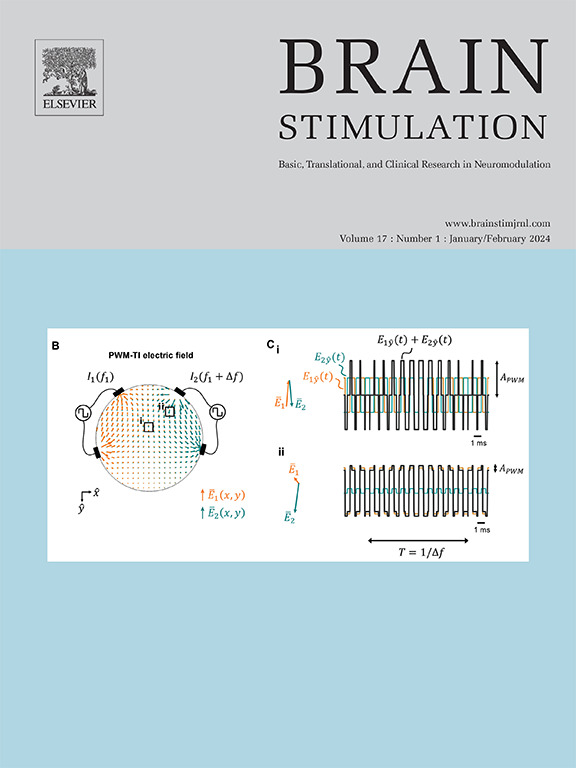急性齿状核脑深部刺激调节慢性脑卒中幸存者的皮质运动兴奋性。
IF 7.6
1区 医学
Q1 CLINICAL NEUROLOGY
引用次数: 0
摘要
背景:脑深部齿状核刺激(DN-DBS)是一种改善中风后上肢(UE)运动功能的新疗法。本研究旨在探讨慢性脑卒中患者急性DN-DBS的生理机制。方法:在假对照、双盲、交叉实验(顺序随机)中,12名患有中度至重度UE损伤的慢性卒中参与者接受(急性)单次(≥45分钟)主动DBS和假DBS治疗。采用经颅磁刺激(TMS)评价皮质运动生理学。我们还描述了急性DBS对生理学和基线临床和神经影像学指标的影响,以及慢性DBS对运动功能的影响之间的关系。结果:急性活动性DBS导致同侧皮质运动兴奋性增加,表现为活跃运动阈值最大刺激器输出量(MSO)降低5.2% (p=0.017, d=0.28),但急性假性DBS没有影响。急性DBS患者皮质性兴奋性升高与同侧皮质脊髓束微结构完整性升高相关(p < 0.70, p < 0.69, p < 0.65, p)。结论:急性DN-DBS可导致中重度慢性卒中幸存者皮质性兴奋性升高。急性DN-DBS对生理的影响取决于关键白质束的结构保存,并与慢性DN-DBS引起的运动增益有关。研究结果为DN-DBS作为脑卒中后运动恢复的潜在疗法和TMS监测反应的潜力提供了机制支持。本文章由计算机程序翻译,如有差异,请以英文原文为准。
Acute dentate nucleus deep brain stimulation modulates corticomotor excitability in chronic stroke survivors
Background
Deep brain stimulation of the dentate nucleus (DN-DBS) is an emerging therapy to improve upper extremity (UE) motor function after stroke. This study sought to investigate the physiologic mechanisms of acute DN-DBS in chronic stroke survivors enrolled in a phase I trial for DN-DBS.
Methods
Twelve chronic stroke participants with moderate-to-severe UE impairment received (acute) single sessions (≥45 min) of active DBS and sham DBS in a sham-controlled, double-blind, cross-over experiment (order randomized). Transcranial magnetic stimulation (TMS) was used to evaluate corticomotor physiology. We also characterized the relationship between acute DBS effects on physiology and baseline clinical and neuroimaging measures, and chronic DBS effects on motor function.
Results
Acute active DBS led to an increase in ipsilesional corticomotor excitability evident as a 5.2 % maximal stimulator output (MSO) reduction in active motor threshold (p = 0.017, d = 0.28), but there was no effect of acute sham DBS. Increases in corticomotor excitability observed with acute DBS were associated with higher microstructural integrity of ipsilesional corticospinal tract (r > 0.70, p < 0.017) and dentato-thalamo-cortical pathways (ρ > 0.69, p < 0.022). Gains in corticomotor excitability with acute DBS were associated with higher dexterity gains made with chronic DBS plus rehabilitation (r > 0.65, p < 0.028).
Conclusions
Acute DN-DBS leads to heightened ipsilesional corticomotor excitability in moderate-to-severe chronic stroke survivors. Effects of acute DN-DBS on physiology are contingent upon structural preservation of key white matter tracts and associated with motor gains made with chronic DN-DBS. Findings provide mechanistic support of DN-DBS as a potential therapy for post-stroke motor recovery and potential of TMS to monitor responses.
求助全文
通过发布文献求助,成功后即可免费获取论文全文。
去求助
来源期刊

Brain Stimulation
医学-临床神经学
CiteScore
13.10
自引率
9.10%
发文量
256
审稿时长
72 days
期刊介绍:
Brain Stimulation publishes on the entire field of brain stimulation, including noninvasive and invasive techniques and technologies that alter brain function through the use of electrical, magnetic, radiowave, or focally targeted pharmacologic stimulation.
Brain Stimulation aims to be the premier journal for publication of original research in the field of neuromodulation. The journal includes: a) Original articles; b) Short Communications; c) Invited and original reviews; d) Technology and methodological perspectives (reviews of new devices, description of new methods, etc.); and e) Letters to the Editor. Special issues of the journal will be considered based on scientific merit.
 求助内容:
求助内容: 应助结果提醒方式:
应助结果提醒方式:


